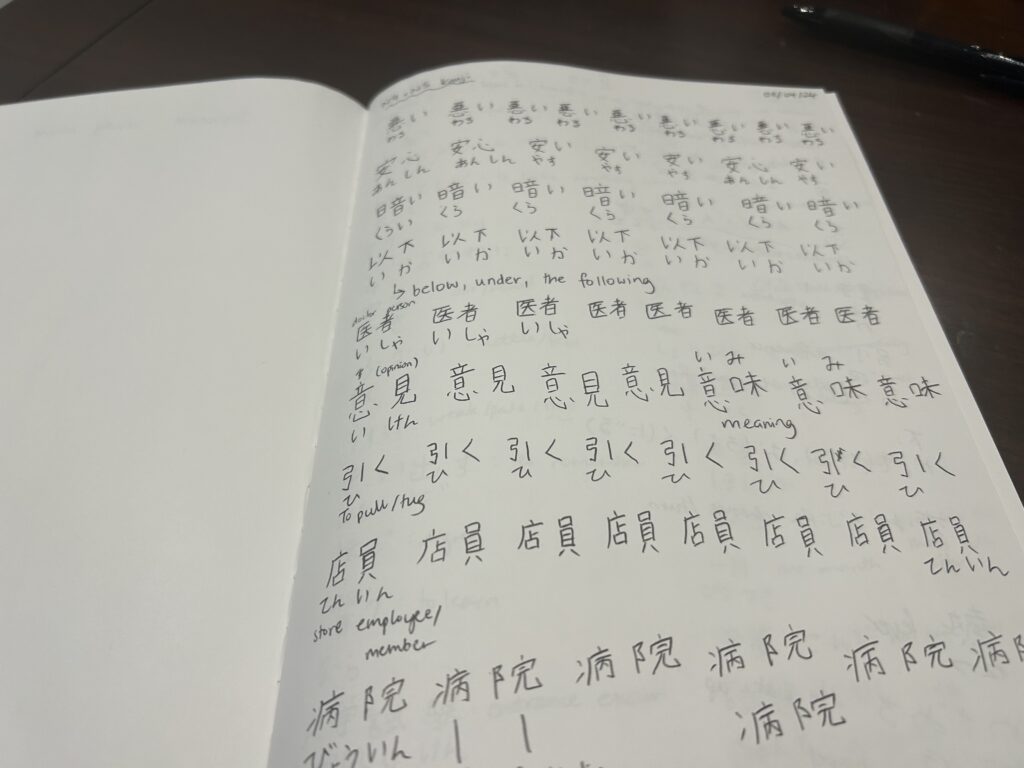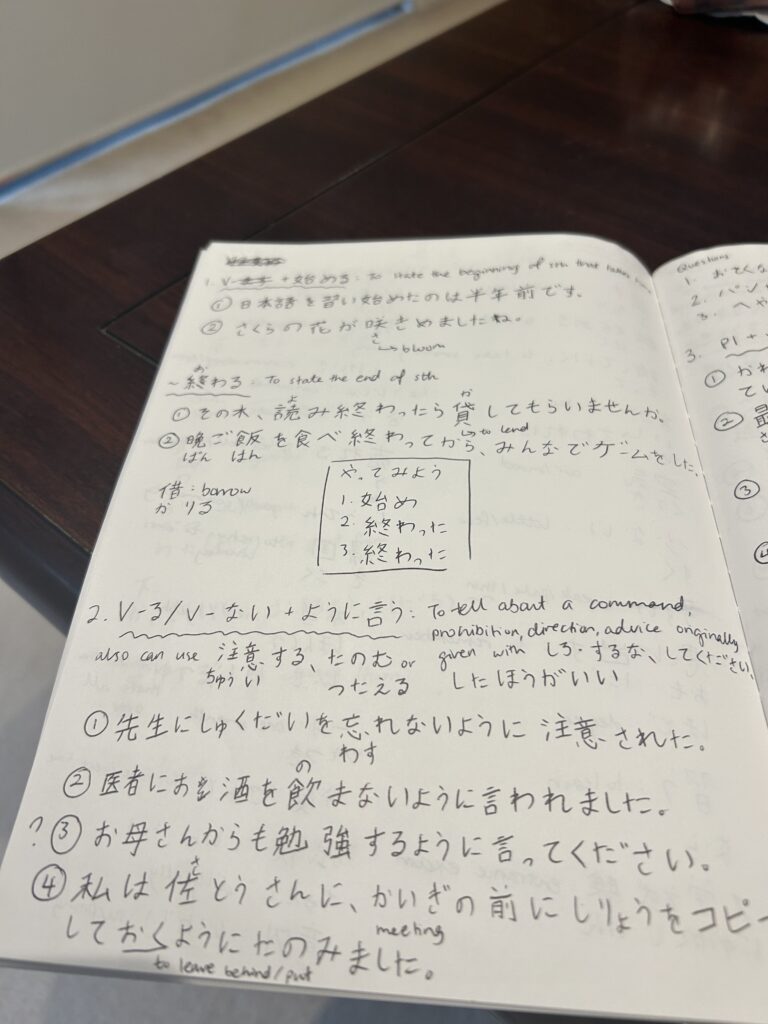The following article contains affiliate links which means I may receive a small commission at no cost to you if you decide to make a purchase.
This is the first part of an ongoing series where I will be documenting and sharing my journey of learning Japanese in 2024 as I prepare for the JLPT N3 exam at the end of the year. A lot of this advice is applicable to JLPT N4 and N5 test takers and I will include links and resources for you guys at the end. I hope to share my experiences, my struggles and advice with any of you who are also trying to learn Japanese or are just interested in following along.
Disclaimer: I studied Japanese for two years during high school and undertook a semester exchange during university where I studied it again for approximately four months. I personally felt it would be a reasonable challenge for me to prepare for the N3 exam but this may not be the case for everyone depending on your learning journey.
JLPT N3 Resources:
- Try! Japanese Language Proficiency Test N3 Revised Edition
- New Kanzen Master Kanji N3
- (Full set) JLPT New Kanzen Master N3 for Learning Japanese
- Shirabe Jisho
- AnkiApp
What Resources I Used (Textbooks and Apps)
If you want to start with the same textbook as me, I am using the Try! Japanese Language Proficiency Test N3 Revised Edition to learn grammar. I find this textbook to be very helpful as each chapter is written very concisely with explanations and examples of each grammar point, a rating of their importance to the exam, supplementary practice questions and a holistic review at the end of each chapter.
Concurrently with grammar, I am also studying kanji. Kanji is personally my biggest weakness and I know it is a headache for many Japanese learners. I highly recommend starting kanji practice as early as possible so you have time to familiarize yourself with the characters and their readings. I lack a lot of foundational kanji so I used the booklet from the New Kanzen Master Kanji N3 where they luckily provide the 300 kanji you need to have mastered for N4 and N5.
In order to learn these quickly, I downloaded AnkiApp which is a free app for flashcards. I started building my own deck where I input around 10-20 words from the list each day and consistently reviewed the whole deck. If you do not wish to build your own deck, you can also search for existing ones available.
Additionally, I’ve had Shirabe Jisho installed on my phone for a long time. It is my go-to Japanese-English dictionary as it allows you to search unknown kanji by writing it. It also provides onyomi and kunyomi readings, example sentences and verb conjugations.

The Beginning of the 8-Month Journey
Mistakes to Avoid
The first mistake I made was unsurprisingly in relation to kanji. Actually, the first mistake I made was not clearly recognizing that the JLPT is multiple-choice. What that means is you are not expected to write any kanji.
Of course, practicing writing kanji will still help you in the long run, especially if you write Japanese essays or plan to live or work in Japan. However in the context of the JLPT, focusing on writing is completely unnecessary. You should be spending your time on recognition and onyomi/kunyomi readings.

How I Use Flashcards
After realizing I’d spent 20 minutes on a task which was not going to help me that much, I finally turned to AnkiApp and started making N4 and N5 vocabulary flashcards from the New Kanzen Master Kanji N3 booklet. I also added any kanji vocabulary that I didn’t know while studying from the Try! textbook.
On the front, I placed the kanji characters like so and put the reading in hiragana as well as the meaning in the back.
悪い | わるい Bad |
On each flashcard, you can rate how well you did from ‘Fail’ to ‘Easy’ so the app knows which ones you need to keep reviewing. You can also choose how many cards you want in each review session. I set mine at 10 so it wasn’t overwhelming. I added approximately 10-20 words a day and kept spamming practice.
Of course, I also got caught up in other responsibilities and took long breaks which meant that I wasn’t reviewing every day. However, being consistent when you can will surely yield results sooner or later. Remember that it is a marathon, not a sprint.
For me, these flashcards were significantly more engaging and motivational than doing kanji practice by writing tens or hundreds of characters. That then made it easy for me to do a round of review in between other work, on the train or just before bed.
Learning Japanese Grammar
At the beginning of each chapter, I dedicated a page to vocabulary. On that page, I wrote down unfamiliar words and definitions from the reading passage and example sentences. That way, when I reviewed the chapter after completing it, I could refer straight back to this page if I came across a term I didn’t know.

On the following pages, I wrote down each grammar structure with the context they were used in as the heading. Under it, I copied each example sentence with relevant notes about definitions or furigana.
I also attempted the questions at the end of each grammar point, trying my best to avoid looking back at my notes too much.
Pacing Yourself

Because you are learning on your own, it’s very easy to get overwhelmed.
Remember that you’re learning another language and it’ll take time to get accustomed to its patterns and nuances. Be kind to yourself.
For the first few days, I was definitely trying to cram in as much learning as possible. All that did was make me mentally exhausted without a proper grasp of any of the points I’d covered.
To really retain what you’ve learned, I recommend only covering up to 2 grammar points each session. Then spend some time going over the example sentences and familiarizing yourself.
Don’t spend more than an hour in total when you study. As someone who works a full-time job, my brain is already tired once I get home. That’s when we need to recognize our limits so learning Japanese is still a fun experience.
Surrounding Yourself with Japanese
The final thing I did in the early stages of Japanese learning was trying to immerse myself in Japanese. As you may have heard people say, one of the most effective ways of learning a language is media consumption. I have experienced firsthand how watching the same series or videos again and again will improve your language mastery.
After some research, I found two chrome extensions: Youtube Dual Subtitles and Nflx MultiSubs. These two extensions are completely free and they allow you to have dual subtitles on Youtube and Netflix respectively. I’m not sponsored for this but I want to emphasize how helpful these tools have been for reinforcing my reading (especially kanji).
Also it gives you an excuse to watch anime guilt-free in the name of learning!
Summary and Key Advice
Overall, the main points are:
- Buy just 1 or 2 textbooks to get started and do some research’; I recommend Try! or books from the Kanzen Master set
- Use Anki App or any other flashcards app for kanji
- Spend a lot of time on recognizing and reading kanji
- Keep vocabulary lists for your future reference
- Cover two grammar points each day and pace yourself
- Spend time familiarizing yourself with example sentences and scenarios to grasp the nuances
- Download the two recommended extensions: Youtube Dual Subtitles and Nflx MultiSubs
- Be kind to yourself and have fun in the process!
Click here to check out our other posts and stay updated on my Japanese learning journey.
JLPT N5 Resources:
JLPT N4 Resources:
- Try! Japanese Language Proficiency Test N4 Revised Edition
- NEW KANZEN MASTER N4 KANJI
- (Kanzen Set) Shin Kanzen Master JLPT N4 and Hiragana Katakana Useful Words Chart 6 Books Set Textbook Binding
JLPT N4 + N5 Resources:

